The Lexus RX used to come standard with a V6. Hence RX350 – the numbers after the letters denoting the size of the V6 (3.5 liters) it came standard with.
The V6 is gone now, alas – although the number remains the same. Probably because “RX240” – which would denote the 2.4 liter four cylinder engine the current RX comes standard with – wouldn’t quite have the same ring to it. 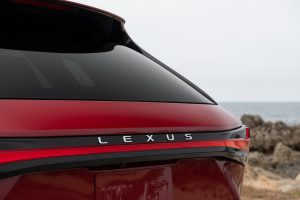
But, there is another number – and letter – denoting an RX that might have a better ring to it.
RX350h.
The “h” in italics to emphasize the hybrid drivetrain that propels this version of the popular RX crossover 37 miles (in city driving) on a gallon of gas. That’s 15 miles farther down the road than the RX350 – without the h – can make it. And 17 farther than the previous-generation (2022) RX350 – with a V6 – could make it.
Of course, there’s a price to be paid for this.
The hybrid RX costs about $3,700 more to buy than the ’22 RX350 (with the V6). But, it only costs $1,600 more than the ’23 RX350 – without the “h.”
So while you will be spending more money to buy a new RX, you don’t have to spend a lot more to save some of that back.
The Lexus RX is the original luxury crossover – the one that spawned them all.
It dates back to 1998 – a time before there were “crossovers,” luxury or otherwise. At that time, there were cars and trucks and the then-new thing, SUVs – the latter being passenger-carrying 4x4s based on trucks.
These SUVs – models like the Ford Explorer especially – were hugely popular, because they were more than cars but weren’t trucks in that they didn’t have beds. Instead, the bed was enclosed and carpeted, so as to carry more people.
But these SUVs were still based on trucks – and their origins manifested in ways that reminded those who owned them where they descended from. Sometimes, not pleasantly (viz, the debacle arising from a combination of the original Explorer’s high-speed stability foibles and the general ignorance of people who drove their Explorers as if they were cars and expected them to handle as if they were).
Lexus took a luxury car – the ES sedan – and turned it into the RX, a luxury crossover. It had more room (especially for cargo) than the sedan it was based on and rode higher off the ground, which (along with available AWD) made it a far-superior snow-day vehicle than a low-riding car (even with AWD). But it still rode like a luxury car, which made it more agreeable to drive than a truck that had been converted into a luxury SUV.
Fast forward 24 years and most luxury brands are selling mostly luxury crossovers. Some sell nothing else. So the RX has a lot of imitators as well as a lot of competition.
But it’s still its own thing.
Base price for the ’23 RX350h – which will be the focus of this review – is $49,000 (vs. $47,400 for the non-hybrid RX350). A top-of-the-line Lux trim stickers for $57,000. It includes suede Alcantara door trim, a heads-up display, 21 inch wheels and premium perforated leather seats, among the highlights.
The ’23 RX – hybrid and standard – are both heavily updated for the new model year. Both are the first-ever four-cylinder-only RXs.
A plug-in RX450h will join the lineup later this year, along with a higher-performance RX500h F Sport.
The longer/three-row RX350L appears to have been discontinued.
What’s Good
Multiple hybrid configurations available.
Entry-level RX350h’s buy-in cost is only slightly higher than the cost of the non-hybrid RX350.
Not as big – and less expensive – than rivals like the Acura MDX.
What’s Not So Good
More expensive than it was before.
Smaller, less powerful standard engine than before.
Not as much cargo space as rivals like the MDX, which still comes standard with a V6.
The standard (non-hybrid) RX350 is powered by a 2.4 liter four cylinder engine that makes 20 horsepower less (275) than the 3.5 liter V6 (295 horsepower) that used to be the RX350’s standard engine.
Readers of this column already know why the V6 has been replaced. And the reason isn’t gas mileage. The new four rates 22 city, 29 highway. The old V6 rated 20 city, 27 highway. That 2 miles-per-gallon difference isn’t much of a difference, especially given the 20 horsepower-less difference.
The reason for nixing the V6 is that it produced more gas – C02 – than the four. At least, hypothetically.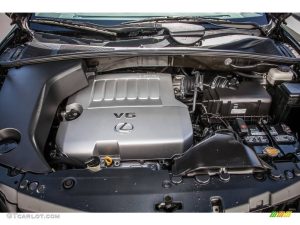
Hypothetically, a smaller engine burns less gas – and so emits less. And since C02 gasses can’t be scrubbed clean (because C02 isn’t “dirty”) the only way to end up with less coming out of the tailpipe is to have less engine connected to the tailpipe.
Hypothetically.
Actually, probably not. Or rather, not much difference.
If the smaller engine is turbocharged to make up for not being larger, as here. The turbo boosts the output of the little four to within 20 horsepower of the much larger 3.5 V6. But – Catch 22 – when it is under boost, the little engine is effectively a larger engine. A comparable amount of gas is being burned – and so, produced. The only way to meaningfully reduce the latter is to keep off the gas.
But it satisfies the regs – and that, increasingly, directs the way new vehicles are designed.
Thus, the RX350 is shy two cylinders and 20 horses – but Uncle is appeased.
With the V6 off the table, Lexus probably realized it better put something else on the table. That would be the hybrid drivetrain in the RX350h. It also uses a four cylinder engine – but a slightly larger (2.5) liter one, working with a nickel metal hydride (not lithium-ion) battery pack to summon a total of 246 horsepower and 37 miles-per-gallon in city driving and 34 on the highway. That is a big difference vs. the old V6. It is also a big difference vs. the new four that’s used in the non-hybrid RX350, especially in view of the very slight-in-the-scheme-of-things difference in price (just $1,600) between the two. If it saves you about $30 each month to drive the hybrid vs. the non, you will have saved about $2,800 in gas bills over eight years.
AWD is also standard with the hybrid layout; it isn’t with the non-hybrid RX. When the non-hybrid RX350 is optioned with AWD, it stickers for the same as the hybrid RX350h, which means the fuel savings are money back in your pocket right away vs. down the road.
There are also two more hybrid options, as already detailed. The plug-in RX450h and the RX500h. The 2023 RX is the only model in this class or otherwise to offer three different hybrid combinations and a non-hybrid variant.
On The Road
Those considering an electric car might want to have a look at a this part-time electric car. The hybrid layout is objectively superior in numerous ways. You never have to worry about running out of range – and a long wait. But you will also likely never have to worry about replacing a tiring battery pack, because the hybrid layout doesn’t wring the life out of its battery pack to keep you moving.
The system not only charges the battery as you drive, it prevents the battery from being heavily discharged as you drive. With a full-time EV, the battery wilts the farther (and faster) you drive. The only way to avoid this is to not drive very far (or very fast) which is kind of like having an ice cream cone you can only lick a little bit.
With a hybrid like the RX350h, you can drive as far you like – which is more than 600 miles in city driving (and just shy of that on the highway) and even if you keep pedal to the metal, you won’t suck all the motive power out of the battery.
The RX350h isn’t the quickest thing in the class. It gets to 60 in about 7.4 seconds. But it goes a lot farther than anything else in the class – electric or otherwise.
Being a Lexus, this RX is on the cush side of the spectrum. The seats are soft and so is everything else, down to the suede Alcantra trim on the upper door panels and dash. It is all on purpose because that is what the RX has always been all about. There are sportier models on the market – Acura’s MDX, for instance – but Lexus is not competing for the same kind of buyer. So, even though you can dial up Sport mode and there are some sporty-looking things about, such as the gear selector on the console that looks and feels almost like a trigger for a .380 Beretta – the RX is much as it was and that is probably good.
The only thing not calming about the new RX is the plethora – El Guapo voice – of driver “assistance” technology, which includes a “distracted driver” monitor that maybe sounds helpful and even necessary (given how many people get distracted while driving) in principle, in fact the function leaves much to be desired. There are a pair of eye movement sensors built into the upper portion of the steering column and these cause a distracting chime to go off when you aren’t distracted.
Until now you are – by the chime.
On several occasions, the system decided I was “distracted” even though I know – because I was deliberately experimenting with the system – I was not. My eyes were on the road, but apparently that’s not how the system perceived it. This is a general problem with driver-assistance technology, which can be rather distracting when you’re just trying to drive the vehicle.
At The Curb
The changes to the RX’s cosmetics are more subtle than the changes to its mechanicals. If you park the ’23 beside the ’22 you will see the more angular lines of the new RX, the bolder-looking grille and you may even perceive it as being a more substantial-looking vehicle than it was before, even though the new RX is exactly the same length (192.5 inches) as the old.
But the wheelbase has been increased by 2.36 inches and the track widened by about half an inch, both of which cause the eye to see it as larger than it was – unless parked side by side the old model.
It is right-sized for four adults, with room for five (three in back) in a pinch. The extended length RX350L has been discontinued, so the RX is now a smaller-scale alternative to three-row available luxury crossovers like the Acura MDX.
There’s a new – larger – LCD touchscreen offset to the right of the main gauge cluster – but it’s not all tap/swipe. There are rotary knobs to adjust the cabin temperature and also for the volume of the audio system (with secondary audio controls on a steering wheel-mounted pad). The only thing that’s missing is a manual-control for the tuner. If you want to change stations/sources you will have to tape/swipe.
The doors open by electric actuation; a light touch is all it takes. Another feature you may like is the adjustable cupholders. They adjust up and down – to accommodate cups of different heights.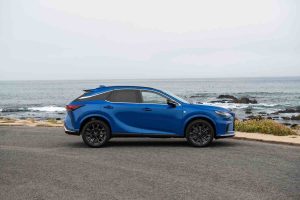
There’s also still a 12V power point – in addition to the latest USB “C” hook-ups, of which there are six.
The Rest
The new RX has a navigation system, as you’d expect. But it is a subscription-based system called Drive Connect. Pros of this system include faster and more up-to-date search results. The main con is that you have to pay continuously to use it – like satellite radio.
The Bottom Line
It’s not easy placating the regulators while satisfying customers. We’ll see how this new RX does with the latter.
. . .
If you like what you’ve found here please consider supporting EPautos.
We depend on you to keep the wheels turning!
Our donate button is here.
If you prefer not to use PayPal, our mailing address is:
EPautos
721 Hummingbird Lane SE
Copper Hill, VA 24079
PS: Get an EPautos magnet or sticker or coaster in return for a $20 or more one-time donation or a $10 or more monthly recurring donation. (Please be sure to tell us you want a magnet or sticker or coaster – and also, provide an address, so we know where to mail the thing!)
My eBook about car buying (new and used) is also available for your favorite price – free! Click here. If that fails, email me at EPeters952@yahoo.com and I will send you a copy directly!




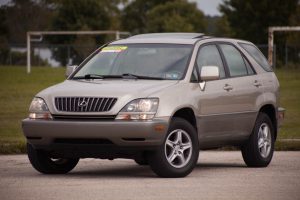


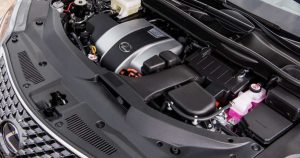








What’s the POINT of having a luxury vehicle if one can’t have the luxury experience of a larger, more unique engine? It seems to me that, if I want a 4 cyl crossover hybrid, I could get a Toyota, Ford, or Chevy counterpart for tens of thousands less, all while having the same capabilities as the “luxury” crossover.
I agree, Mark –
The previous V6 RX was a superb vehicle; the V6 being the centerpiece of the reasons why. Just a brilliant engine. Smooth, quiet, powerful and immensely reliable. All gone now.
Eric, Great comment re the “brilliant” V6 engine in the previous RX.
It’s practically astonishing in a RAV4 – last model year for a RAV4 V6 was 2012.
Eric – “There are a pair of eye movement sensors built into the upper portion of the steering column and these cause a distracting chime to go off when you aren’t distracted.”
How I learned to love the Bomb and Big Brother.
Reckon hybrids (& EV’s for that matter) would be *very good* in the snow, with the extra weight, down low in the frame and AWD, yes? Also, has anybody heard of the long term durability of hybrid battery packs? I mean, when the 1st gen Prius came out, that was a big criticism of them (still true today) about the lifetime of expensive battery packs. Well, the Prius has been around enough that we should have some history on that aspect of the hybrid design. Any history/reports on this, Eric? Curious
Hi MDP,
The basic layout does help in snow; the weakness is often the tires – which are too wide and the wrong tread type (for snow). This is a common problem with many AWD vehicles. The good news is it’s easily remedied by using the right tires.
As far as the battery packs: Hybrids have been around and in general use for 20-plus years. The battery packs seem to last 12-15 years. They are also a lot less expensive to replace than an EV battery, which is much larger and so more expensive. It seems reasonable me to spend say $2k on a new/refurbished battery for an otherwise sound 12-15 year-old hybrid. It does not seem reasonable to me to spend $15,000 on a new battery for ten-year-old EV.
I have a good friend who bought a 2006 Prius brand new. Still has it, original batteries, never had a repair or problems of any kind. Car actually still looks and feels pretty new to me when I get in it. If the batteries went bad and he junked it tomorrow, I’d say he still got more than his money’s worth out of it.
Eric,
Scotty Kilmer recently featured a customer’s Prius on his YouTube channel. It was like 10-12 years old, and it had 140K miles on the clock; the battery was still working fine.
Wonder what it will be like for the third or fourth owners of these. I realize that automakers are building for the first owners of them mainly. I am sure the four cylinder is fine as a new vehicle, but as a fifteen year old one, they are not likely to be great. Even with the turbo, its far too small. Toyota is likely a better gamble then some of the other makes, if it’s history shows.
I suppose its part of the plan to make electric look “better” too. Put undersized engines in overweight vehicles…..sigh…..
It just doesn’t scream luxury vehicle or even premium with a four cylinder engine under the hood. I am not the target market for this, but spending that kind of money, I want way more engine for my depressed Biden-bucks. I suppose I would be buying a Camry V6 as I really don’t care if Lexus is on it rather than Toyota. Kind of weird that still exists, imagine only a year or two more at this point.
Wonder what it will take to bring sanity back to the auto-making business. Seems like it’s gonna get way worse before it gets better again. It would be fun to watch Elon bring out an ICE car if some sanity came back. Wonder if he could pivot fast enough to survive having to actually make money making cars.
Looks like the RX350h is still afflicted with the wide-mouth, sharks-face guppy grille that first afflicted us 15 or 20 years ago.
It’s over, guys. Give it a freaking rest. Your car looks like a menacing bug that needs to be swatted, for the greater good.
The pic of the crushed explorer made me think, this whole car thing started going south with cash for clunkers.
Didn’t realize just how devious that little plan was.
It’s bad affects continue to this day. There is a whole missing generation of old cars. Until Cash for Clunkers, 1990’s cars were still pretty common (at least round my parts). Say what you will about 1990’s cars, but most of them easily could do 200,000+ miles with not much trouble (I got most of my 1990′ cars into the 300,000’s and one into 400,000’s).
But after it, they seemed much more rare. There were lots of old but still very serviceable late 1990’s cars that lower income people really needed to have around for cheap rides. But no, our betters said that they (and their parts) must not be. DESTROYED for no good reason.
Not allowing those cars to be at LEAST parted out, was the straw that broke the camels back in my book with the waste of this so called government “program”.
We feel your pain, bro.
https://tinyurl.com/bfm9yv2b